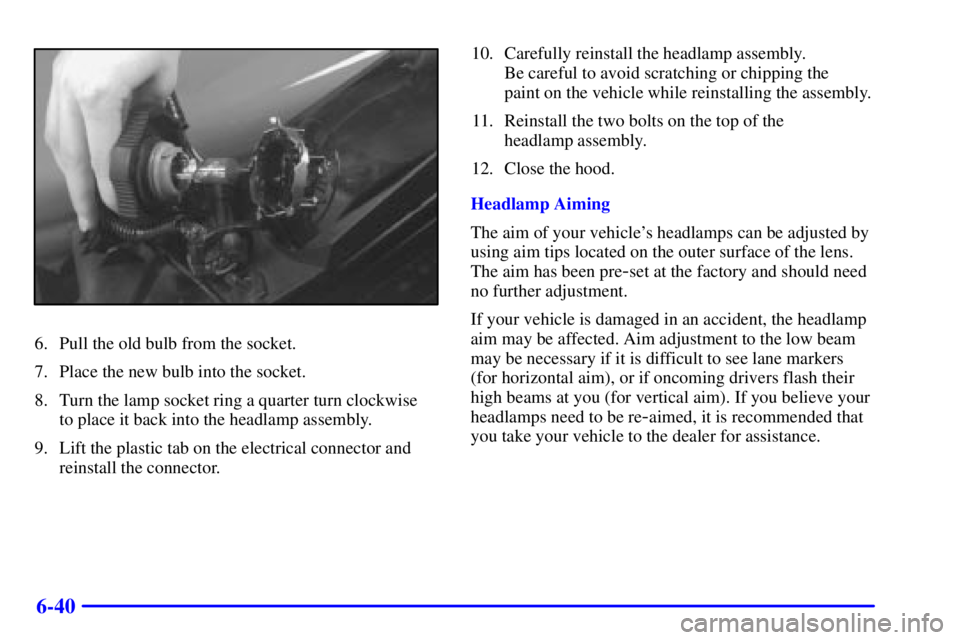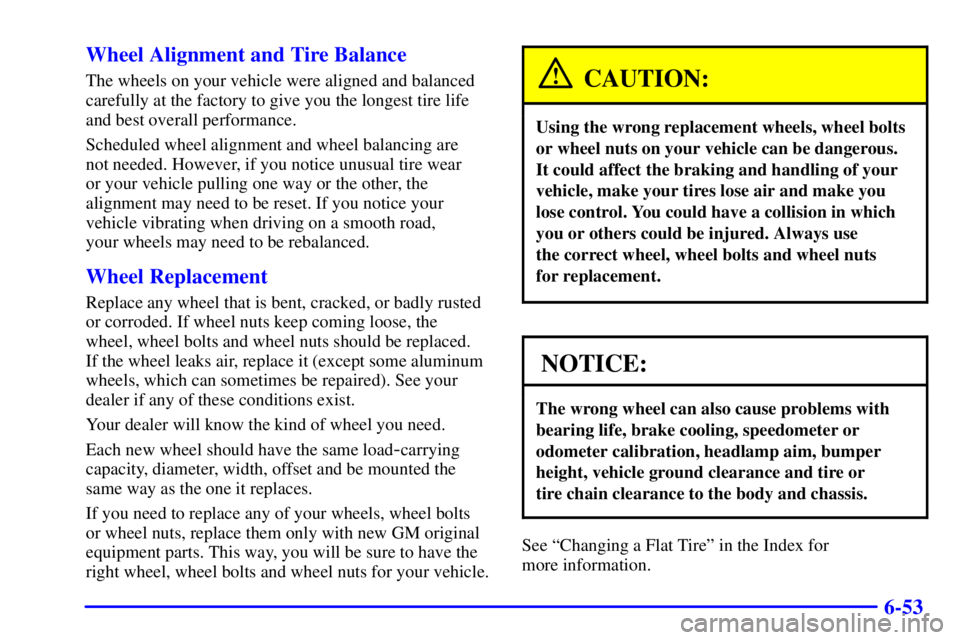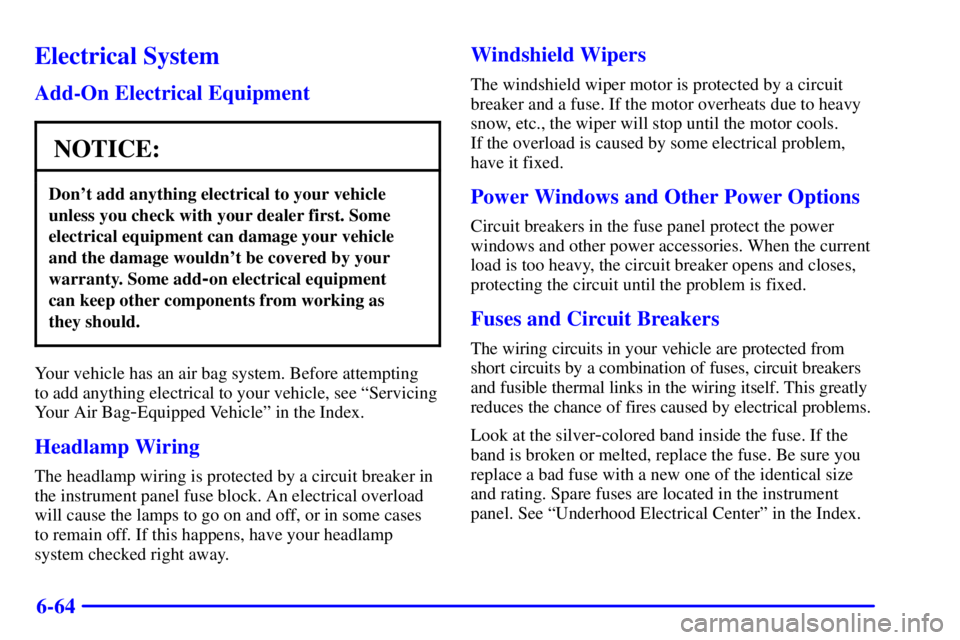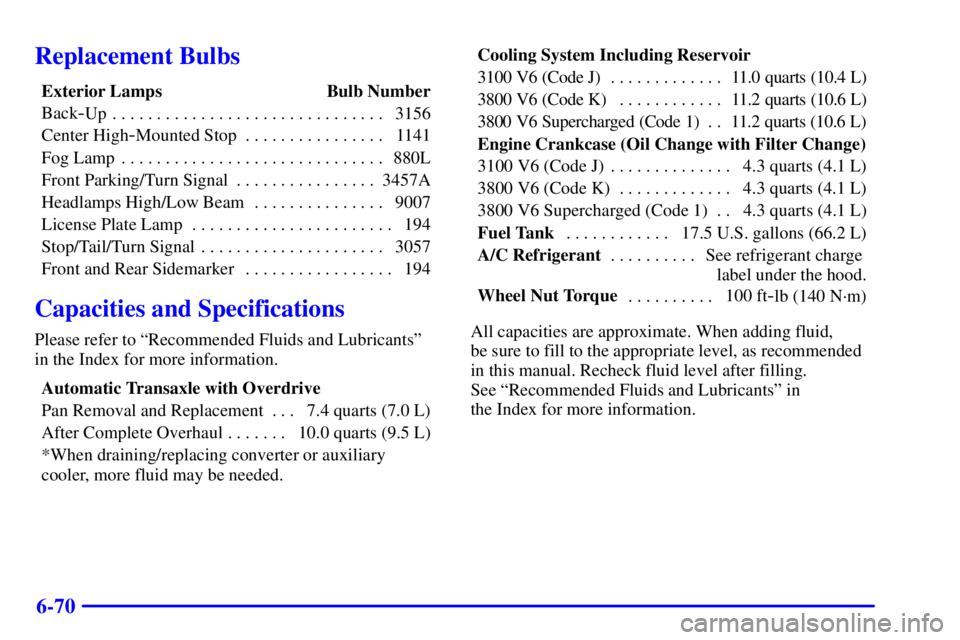Page 301 of 373
6-39
3. Carefully remove the headlamp assembly from the
vehicle. Be careful to avoid scratching or chipping
the paint on the vehicle while removing.
4. Lift the plastic tab on the electrical connector and
pull the connector.5. Turn the lamp socket ring a quarter turn
counterclockwise to remove it from the
headlamp assembly.
Page 302 of 373

6-40
6. Pull the old bulb from the socket.
7. Place the new bulb into the socket.
8. Turn the lamp socket ring a quarter turn clockwise
to place it back into the headlamp assembly.
9. Lift the plastic tab on the electrical connector and
reinstall the connector.10. Carefully reinstall the headlamp assembly.
Be careful to avoid scratching or chipping the
paint on the vehicle while reinstalling the assembly.
11. Reinstall the two bolts on the top of the
headlamp assembly.
12. Close the hood.
Headlamp Aiming
The aim of your vehicle's headlamps can be adjusted by
using aim tips located on the outer surface of the lens.
The aim has been pre
-set at the factory and should need
no further adjustment.
If your vehicle is damaged in an accident, the headlamp
aim may be affected. Aim adjustment to the low beam
may be necessary if it is difficult to see lane markers
(for horizontal aim), or if oncoming drivers flash their
high beams at you (for vertical aim). If you believe your
headlamps need to be re
-aimed, it is recommended that
you take your vehicle to the dealer for assistance.
Page 303 of 373
6-41 Front Turn Signal and Front Sidemarker
1. Open the hood, and support it properly.
2. Remove the two bolts from the top of the
headlamp assembly.
3. Remove the headlamp assembly from the vehicle.
Be careful to avoid scratching or chipping the paint
on the vehicle while removing it.
4. Turn the front sidemarker bulb socket a quarter turn
counterclockwise to remove.
5. Remove the old bulb from the socket.
6. Place the new bulb into the socket.
7. Turn the bulb socket a quarter turn clockwise to
reinstall it.
8. Carefully reinstall the headlamp assembly.
Be careful to avoid scratching or chipping the
paint on the vehicle.
9. Reinstall the two bolts on the top of the
headlamp assembly.
10. Close the hood.
Page 315 of 373

6-53 Wheel Alignment and Tire Balance
The wheels on your vehicle were aligned and balanced
carefully at the factory to give you the longest tire life
and best overall performance.
Scheduled wheel alignment and wheel balancing are
not needed. However, if you notice unusual tire wear
or your vehicle pulling one way or the other, the
alignment may need to be reset. If you notice your
vehicle vibrating when driving on a smooth road,
your wheels may need to be rebalanced.
Wheel Replacement
Replace any wheel that is bent, cracked, or badly rusted
or corroded. If wheel nuts keep coming loose, the
wheel, wheel bolts and wheel nuts should be replaced.
If the wheel leaks air, replace it (except some aluminum
wheels, which can sometimes be repaired). See your
dealer if any of these conditions exist.
Your dealer will know the kind of wheel you need.
Each new wheel should have the same load
-carrying
capacity, diameter, width, offset and be mounted the
same way as the one it replaces.
If you need to replace any of your wheels, wheel bolts
or wheel nuts, replace them only with new GM original
equipment parts. This way, you will be sure to have the
right wheel, wheel bolts and wheel nuts for your vehicle.
CAUTION:
Using the wrong replacement wheels, wheel bolts
or wheel nuts on your vehicle can be dangerous.
It could affect the braking and handling of your
vehicle, make your tires lose air and make you
lose control. You could have a collision in which
you or others could be injured. Always use
the correct wheel, wheel bolts and wheel nuts
for replacement.
NOTICE:
The wrong wheel can also cause problems with
bearing life, brake cooling, speedometer or
odometer calibration, headlamp aim, bumper
height, vehicle ground clearance and tire or
tire chain clearance to the body and chassis.
See ªChanging a Flat Tireº in the Index for
more information.
Page 326 of 373

6-64
Electrical System
Add-On Electrical Equipment
NOTICE:
Don't add anything electrical to your vehicle
unless you check with your dealer first. Some
electrical equipment can damage your vehicle
and the damage wouldn't be covered by your
warranty. Some add
-on electrical equipment
can keep other components from working as
they should.
Your vehicle has an air bag system. Before attempting
to add anything electrical to your vehicle, see ªServicing
Your Air Bag
-Equipped Vehicleº in the Index.
Headlamp Wiring
The headlamp wiring is protected by a circuit breaker in
the instrument panel fuse block. An electrical overload
will cause the lamps to go on and off, or in some cases
to remain off. If this happens, have your headlamp
system checked right away.
Windshield Wipers
The windshield wiper motor is protected by a circuit
breaker and a fuse. If the motor overheats due to heavy
snow, etc., the wiper will stop until the motor cools.
If the overload is caused by some electrical problem,
have it fixed.
Power Windows and Other Power Options
Circuit breakers in the fuse panel protect the power
windows and other power accessories. When the current
load is too heavy, the circuit breaker opens and closes,
protecting the circuit until the problem is fixed.
Fuses and Circuit Breakers
The wiring circuits in your vehicle are protected from
short circuits by a combination of fuses, circuit breakers
and fusible thermal links in the wiring itself. This greatly
reduces the chance of fires caused by electrical problems.
Look at the silver
-colored band inside the fuse. If the
band is broken or melted, replace the fuse. Be sure you
replace a bad fuse with a new one of the identical size
and rating. Spare fuses are located in the instrument
panel. See ªUnderhood Electrical Centerº in the Index.
Page 327 of 373
6-65
Instrument Panel Fuse Block
Some fuses are in a fuse block located inside of the
glove box behind a small bin on the right side. To open,
pull the cover out. The fuse block is inside. On the back
edge of this cover is a fuse puller and a fuse usage chart.
To use the fuse puller, place the wide end of the fuse
puller over the plastic end of the fuse. Squeeze the ends
over the fuse and pull it out.
To reinstall the bin, position the lower end and turn
the top into position. Press on the sides until it snaps
into place.Circuit Breaker Description
HEADLAMP Headlamps
SEAT Power Seat, Power Lumbar
BLANK Blank
PWR WDO Power Windows
BLANK Blank
Page 330 of 373
6-68
Fuse Description
1 Cooling Fan 2
2 Spare
3 Headlamps
4 Battery Main 2
5 Ignition Main 1
6 Cooling Fan 1 Fuse Description
7 Battery Main 1
8 Ignition Main 2
18 Fuel Injections
19 Spare
20 Spare
21 Mass Air Flow (MAF),
Heated Sensors, Canister Purge,
Boost Solenoid
22 Spare
23 Spare
24 Spare
25 Ignition Module
26 Spare
27 Trunk Release, Back
-Up Lamps
28 AC Clutch, ABS Ignition
29 Remote Keyless Entry,
Theft
-Deterrent, Shock Sensor,
Trip Computer, HVAC Module,
Security LED
Page 332 of 373

6-70
Replacement Bulbs
Exterior Lamps Bulb Number
Back
-Up 3156. . . . . . . . . . . . . . . . . . . . . . . . . . . . . . .
Center High
-Mounted Stop 1141. . . . . . . . . . . . . . . .
Fog Lamp 880L. . . . . . . . . . . . . . . . . . . . . . . . . . . . . .
Front Parking/Turn Signal 3457A. . . . . . . . . . . . . . . .
Headlamps High/Low Beam 9007. . . . . . . . . . . . . . .
License Plate Lamp 194. . . . . . . . . . . . . . . . . . . . . . .
Stop/Tail/Turn Signal 3057. . . . . . . . . . . . . . . . . . . . .
Front and Rear Sidemarker 194. . . . . . . . . . . . . . . . .
Capacities and Specifications
Please refer to ªRecommended Fluids and Lubricantsº
in the Index for more information.
Automatic Transaxle with Overdrive
Pan Removal and Replacement 7.4 quarts (7.0 L). . .
After Complete Overhaul 10.0 quarts (9.5 L). . . . . . .
*When draining/replacing converter or auxiliary
cooler, more fluid may be needed.Cooling System Including Reservoir
3100 V6 (Code J) 11.0 quarts (10.4 L). . . . . . . . . . . . .
3800 V6 (Code K) 11.2 quarts (10.6 L). . . . . . . . . . . .
3800 V6 Supercharged (Code 1) 11.2 quarts (10.6 L). .
Engine Crankcase (Oil Change with Filter Change)
3100 V6 (Code J) 4.3 quarts (4.1 L). . . . . . . . . . . . . .
3800 V6 (Code K) 4.3 quarts (4.1 L). . . . . . . . . . . . .
3800 V6 Supercharged (Code 1) 4.3 quarts (4.1 L). .
Fuel Tank17.5 U.S. gallons (66.2 L) . . . . . . . . . . . .
A/C RefrigerantSee refrigerant charge . . . . . . . . . .
label under the hood.
Wheel Nut Torque100 ft
-lb (140 N´m) . . . . . . . . . .
All capacities are approximate. When adding fluid,
be sure to fill to the appropriate level, as recommended
in this manual. Recheck fluid level after filling.
See ªRecommended Fluids and Lubricantsº in
the Index for more information.
Page:
< prev 1-8 9-16 17-24